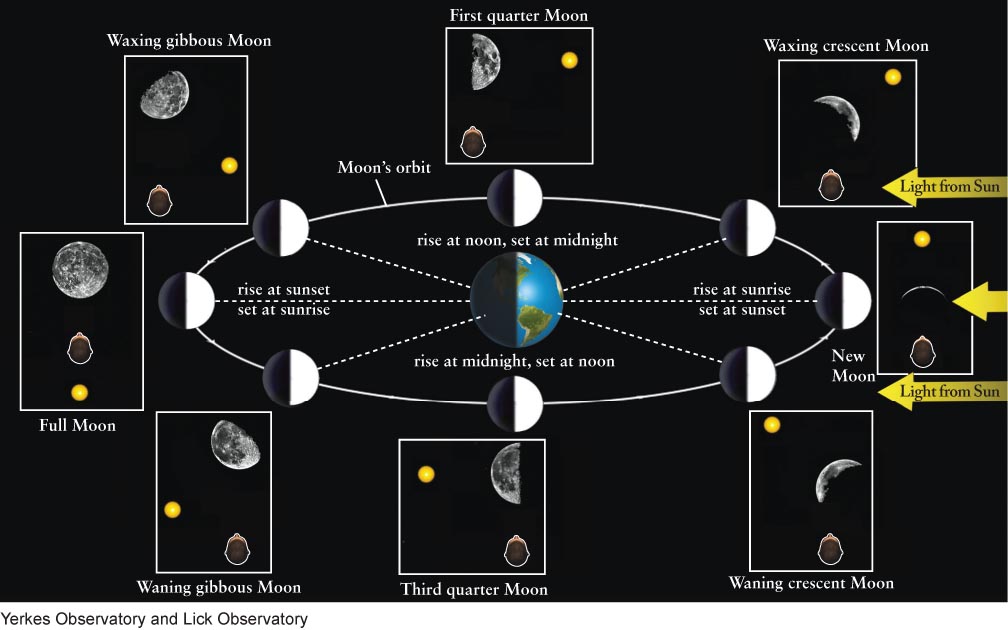THE PHASES OF THE MOON
1-10 The phases of the Moon originally inspired the concept of the month
While the Moon’s precessional effect on Earth unfolds over millennia, many lunar effects are noticeable every day. As the Moon orbits Earth, it moves from west to east (right to left) on the celestial sphere, changing position among the background stars. Its position relative to the Sun also changes and, as a result, we see different lunar phases.
The Sun illuminates half of the Moon at all times (Figure 1-20). The Moon’s phase that we see depends on how much of its sunlit hemisphere is facing Earth. When the Moon is closest to the Sun in the sky, its dark hemisphere faces Earth. This phase, during which the Moon is at most a tiny crescent, is called the new Moon. During the 7 days following the new phase, more of the Moon’s illuminated hemisphere becomes exposed to our view, resulting in a phase called the waxing crescent Moon. At the first quarter Moon, we see half of the illuminated hemisphere and half of the dark hemisphere. “Quarter Moon” refers to how far in its cycle the Moon has gone, rather than what fraction of the Moon appears lit by sunlight.

During the next week, still more of the illuminated hemisphere can be seen from Earth, giving us the phase called the waxing gibbous Moon. “Gibbous” means “rounded on both sides.” When the Moon arrives on the opposite side of Earth from the Sun, we see virtually all the fully illuminated hemisphere. This phase is the full Moon. Over the following 2 weeks, we see less and less of the illuminated hemisphere as the Moon continues along its orbit. This movement produces the phases called the waning gibbous Moon, the third quarter Moon, and the waning crescent Moon. The Moon completes a full cycle of phases in 29½ days.
17
 Confusion often occurs over the terms “far side” and “dark side” of the Moon. The far side is the side of the Moon facing away from Earth. The dark side is the side of the Moon on which the Sun is not shining. By examining the photographs in Figure 1-
Confusion often occurs over the terms “far side” and “dark side” of the Moon. The far side is the side of the Moon facing away from Earth. The dark side is the side of the Moon on which the Sun is not shining. By examining the photographs in Figure 1-
Figure 1-
Focus Question 1-6
Is the Moon waning or waxing in Figure 1-


 Figure 1-
Figure 1-
The approximately 4 weeks that the Moon takes to complete one cycle of its phases inspired our ancestors to invent the concept of a month. Astronomers find it useful to define two types of months, depending on whether the Moon’s motion is measured relative to the stars or to the Sun. Neither type corresponds exactly to the months of our usual calendar, which have different (and, in the case of February, varying) lengths.
The sidereal month is the time it takes the Moon to complete one full orbit of 360° around Earth (Figure 1-22). The length of the sidereal month is determined by the location of the Moon in its orbit around Earth as measured with respect to the stars, analogous to how the sidereal day is measured. Equivalently, this is the time it takes the Moon to start at one place on the celestial sphere and return to exactly the same place again. The sidereal orbital period of the Moon takes approximately 27.3 days. The synodic month, or lunar month, is the time it takes the Moon to complete one 29½-day cycle of phases (for example, from new Moon to new Moon or from full Moon to full Moon) and thus is measured with respect to the Sun rather than the stars.
18
The synodic month is longer than the sidereal month because Earth is orbiting the Sun while the Moon goes through its phases. As shown in Figure 1-
Both the sidereal month and synodic month vary somewhat, because the gravitational pull of the Sun on Earth changes Earth’s orbital speed throughout the year and the gravitational pull of the Sun on the Moon affects the Moon’s speed as it orbits Earth. The sidereal month can vary by as much as 7 hours, while the synodic month can change by as much as 12 hours.
The terms synodic and sidereal are also used in discussing the motion of the other bodies in the solar system. The synodic period of a planet is the time between consecutive straight alignments of the Sun, Earth, and that planet (during which time interval the planet also goes through a cycle of phases, as seen from Earth). Recall that any orbit measured with respect to the stars is called “sidereal,” including orbits of the planets around the Sun, as well as orbits of moons around their planets.
 The Moon During the Day The Moon is visible at some time during daylight hours virtually every day. The time of day or night it is up in our sky depends on its phase.
The Moon During the Day The Moon is visible at some time during daylight hours virtually every day. The time of day or night it is up in our sky depends on its phase.